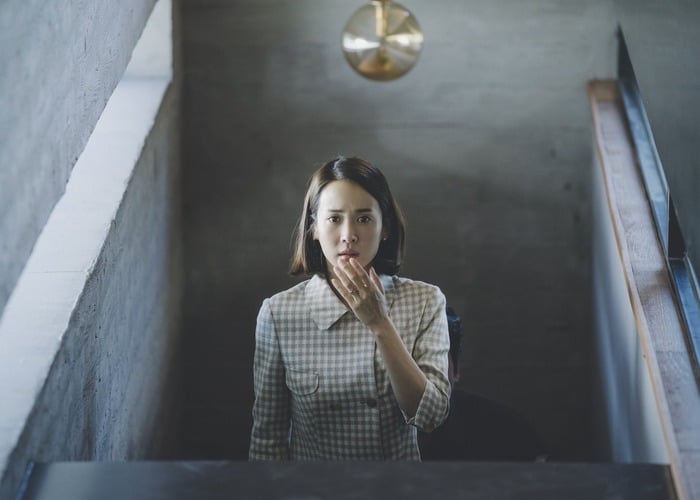Given director Bong Joon-ho’s portfolio of thrilling, allegorical creature-features like The Host (2006) and Okja (2017), it stands to reason that Parasite (2019) would star some eponymous gooey, parasitic monster. Though he claims all of his movies are monster movies, every character in the genre-bending smash-hit is unquestionably human. To what, then, does the title refer? Who, exactly, is the parasite in Parasite?
This is a difficult question to answer, and that is no accident. Fortunately, Bong, with the help of cinematographer Hong Kyung-pyo, uses visual clues throughout the film to help the viewer answer this question — especially in the main set-piece, which was constructed entirely for the making of the film. The architecture of the film is key to being able to crack open the meaning of that compelling title.
Visually, Parasite starts from the bottom and works its way up. Kim Ki-taek (Song Kang-ho) and his family live underground, which is a position they are forced into due to their low-income status. It is an almost comically on-the-nose portrait of poverty: the house is dirty, drunken wanderers urinate by their window, and the family is ultimately forced to live deprived of civilization, and their desperation for work sees them folding pizza boxes for a living while they’re demeaned and ridiculed by their young boss. The camera infiltrates the family space in an intrusive manner, descending upon the Kim family from the streets above, becoming a part of their claustrophobic space. Class separations are immediately defined visually: poor people live underground and rich people live above-ground. That is the world of Parasite. The class divide, here, is literal; the separation line is the ground.
In order to survive, the Kim family has no choice but to act like parasites. In the first scene, Kim Ki-woo (Choi Woo-sik) raises his phone to the ceiling in an attempt to connect with the upstairs coffee shop’s WiFi, and, with it, the upstairs world: the inaccessible world of the wealthy. Ki-woo and his sister Kim Ki-jung (Park So-dam) finally connect to a network and crouch underneath the hot-spot. There, they feed off of it.
The Kim family’s luck begins to change when Ki-woo is offered a job as a tutor for the wealthy Park family. The Park house is beautiful, open, and tasteful. It feels as though it exists in a completely different world than the Kims’ house. And, in a sense, it does. The house is situated on top of a hill, separated from the rest of the city, and especially from the Kims’ underground world. And this elevational separation has more than just a psychological effect on the characters. When the city is the victim of torrential rainfall, for example, it floods and destroys the Kim home. But for the Parks, it merely adds a little excitement and novelty to their backyard camping adventure. The Park house is the perfect visual representation of the upper-class, and its position at the top of the city is no exception.
When the Kim family manages to infiltrate the Park house by assuming roles as their employees, the two families effectively switch places, as revealed visually through their placement in the Park house. Ki-woo’s first session tutoring Park Da-hye (Sung Ji-so) takes place on the first floor, but, once Da-hye’s mother, Park Yeon-kyo (Yeo-jeong Jo) decides Ki-Woo fits in, he is promoted to teach in her bedroom, which is located on the second floor. The same goes for Ki-jung, who is hired as an art therapist for the youngest Park. When Yeon-kyo tries to sit in on that session, Ki-jung instructs her to “wait downstairs.” The Parks have been demoted to the lower half of the house, while the Kims quietly hold them at the end of their puppet strings from the luxurious upstairs.
Each time the Parks go upstairs, a world they unknowingly no longer control, they inadvertently give up a little more power by allowing the Kims to have more and more say over the state of their household. In two of Parasite’s most iconic shots, Yeon-kyo walks up the stairs and is shocked by what she finds at the top. Once, she finds Ki-jung eerily assuming a motherly disposition toward her younger child. After that, she is led to believe her housekeeper is ill and falls victim to yet another clever con conducted by the Kims. They are in control. That is until they’re not.
Half-way through the film, Parasite’s house of cards inevitably collapses and descends into utter, unpredictable chaos. This tonal shift occurs in response to the Kims’ obvious decrease in control. There is a problem with their plan. The family manages to narrowly escape being discovered by the Parks, and, when they do, the landscape that surrounds them reflects that. The camera pans outward, and they are suddenly minuscule — like little insects — crawling down a hefty slope toward their side of the city, like they’re Dante and Virgil, marching deeper and deeper into the winding circles of Hell, in a seemingly never-ending descent to safety.
The problem is that the Kim family is not the Park’s only “parasites”: their plan is disrupted by the discovery of another family living far beneath them in the basement, with neither the Parks nor the Kims aware of its existence. The power struggle between the three families becomes incommensurable, as the Kims and the basement family fight over who gets to be at a higher position in the house, while the Parks are blissfully unaware that a lower-basement level even exists, which is undoubtedly a product of their upper-class status.
In Parasite, there are about as many altitude shifts as there are plot twists. Through this, Bong makes it nearly impossible to discern the direction the narrative will head in, and also provides a thought-provoking class-commentary which asks: who is more parasitic? The creature itself, or the one that feeds it?

